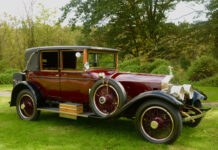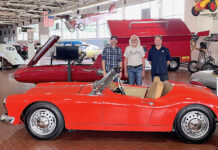By Jay Hirsch
David Dunbar Buick was born in Scotland. In 1858 when he was two years old, his parents came to the Unites States. In the early 1880s, David started work at a plumbing supply business in Flint, Mich., and by the end of the 1880s he was the head of the company. In the 1890s the internal combustion engine attracted David’s attention. Eventually David’s fascination with the workings of the internal combustion engine led to his spending less and less time at the plumbing business, and he and his partner dissolved their partnership and sold the business
In 1902 David set up the Buick Manufacturing Company, which made engines for other car companies in addition to making and selling Buicks. Buick had developed the then-revolutionary “valve-in-head” overhead-valve engine. Overhead cam engines are a variant of OHV engines, so it is accurate to say virtually all modern engines are derivatives of David Buick’s OHV engine invention.
In 1904 Buick was in need of money, and he turned to William Durant, who became the controlling investor in Buick. In 1906 William Durant, who was then president of Buick, gave David a severance package. Buick by now was the cornerstone of what in 1908 was to be the General Motors Company, started by William Durant.
Through the years Buick would come to be known for its quality and engineering. In 1953 Buick moved into the new post WWII United States car market with its first OHV V-8 engine,
As American cars grew in size and power, Buick was among the leaders of this era, along with the 1950s trend to ever bigger V-8 engines and the use of chrome and tailfins, first introduced by Cadillac in 1948. By 1958 this culminated in Buick and Oldsmobile being “the Kings of Chrome”
The 1959 Buick was a completely different car than the chrome-laden 1958 model. It was lower, sleeker, and had flowing lines highlighted by crisp sculpturing.
It was the first Buick since 1949 (except for the 1953/54 Skylarks) that did not have the ventiports on the front fender. Gone also was the great amount of bright-work (chrome) which was used so heavily on the 1958 models, in particular the Buick Limited. Except for the front and rear bumpers, the 1959 Buick was almost devoid of chrome.
The Buick also received new model names for 1959. Out were Special, Century, Super and Roadmaster. In were Le Sabre (the lowest priced Buick), Invicta (the performance Buick), Electra (the luxury series), and Electra 225 (the super luxury series).
Electra Waggoner Biggs was a nationally-known sculptress. She had the honor of having an automobile named after her. In 1959, John Biggs’ brother-in-law, Harlow H. “Red” Curtice, president of Buick Motors, named their luxurious Buick models “Electra.”
The Electra 225 derived its name from its length, 225 inches. The standard Electra was 221 inches. The Le Sabre and Invicta had a wheelbase of 123 inches and were 217.4 inches long. The Le Sabre had an OHV 364 cid V-8/5.9-liter engine, while the other models had the OHV 401 V-8/6.6-liter engine.
The Buick V-8s were dubbed the “Nailhead” due to their relatively small intake and exhaust valves, which resembled nails. The engines became popular with hot-rodders in the 1950s and 1960s, because the vertical attachment of the valve covers enabled the engines to fit into a smaller spaces than other angled V-8s, while still allowing easy access for working on the engines.
In addition to the new, lower-body design was a new chassis. A husky box-section cross member runs laterally between bowed-out side rails. Additional rails run forward from this section, like the legs of the letter K. Less deflection with added torsional strength and rigidity were claimed by the new design.
Air suspension was offered but only on the rear of the car. The front would have the normal coil spring. Fortunately not too many opted for this sounds-great-but–poorly-functionally-designed system. A three-speed manual transmission was standard on the Le Sabre series, with automatic as an option.
The Electra 225 was offered in a four -door, pillarless hardtop with six windows, a four-door-hardtop with pillars, and a convertible, as seen here. The Electra series had a two-door hardtop in addition to a four-door, pillarless-hardtop with four windows. This body style had a pancake-type roof and wrap-around rear window. There were no blind spots, and the driver had 360 degrees of visibility. In the two-door hardtop, the rear glass curved into the roof, giving rear-seat passengers the feeling of being outside.
The Electra 225 seen here is an original car. It is “not restored as new.” The car was bought new in Buffalo, N.Y. and used in the spring and summer. Some years the owner would have the car shipped for December through March to Sarasota, Fla., where the family had a winter home.
Joe Carfagna, the second and current owner, owns American cars from the late 1950s to late 1960s, several being station wagons.
Joe’s primary interest is “original, unrestored cars.” Joe has restored cars that he liked that needed the work, but for Joe “there is nothing like an original car!”
It was in the spring of 2004 when a fellow member of the Buick club told Joe about a glacier-green 1959 Buick Electra 225 that was for sale in Buffalo. Joe called the owner, who was the son of the original owner. He told Joe it “was time for the 225 to have a new home.” The car had been sitting in a four-car garage for a few years, but he did start it every few months and drove it for at least 25 minutes. Before Joe could ask, the owner said “I want [xx] dollars. That is the price!” Joe said he would drive to Buffalo (450 miles) the next weekend with the money. “If the car is what you say it is, I will give you the money, load the car into my enclosed car carrier, and take it home.”
Joe at the time owned another 225 convertible that was under going a full frame off restoration. When Joe got the 225 home, he put it on the lift in his twelve-car garage. The following weekend he and his friend Ken went through the car. The rubber brake lines were replaced, and new wheel cylinders were installed.
Other maintenance work was performed: change of both engine and transmission oils, flushing the radiator, etc. Joe spent a few hours for five weekends gently cleaning the leather interior and then using Neats Foot Oil to keep the leather soft and supple, which he applies a few times a year. The convertible top and the rear plastic window just needed a good cleaning. When Joe thought the car was ready for its maiden voyage, he called me to ask if I could come that Saturday.
“There is nothing like an original car that is well taken care of,” is so true. Unlike a restored car, all the rubber seals on the windows, the doors and trunk fit perfectly. New rubber weather stripping is ether too thick or too thin, no matter who makes or sells the rubber, and Joe can vouch for that. The same for new springs. Unless you literally can get new springs that have been sitting on a shelf in an auto dealer or parts store for years, an old (40 years or more) car with new springs either sits too high or too low, and the car never rides or handles as it did when new. The ride of the 1959 Buick 225 is closer to a 2003 full-size Lincoln or Mercury than to a pre-1958 car.
Three years after buying the glacier-green 225, Joe’s restored red 225 convertible was finished. The car has taken a Junior, Senior and Preservation at the annual AACA fall meet in Hershey, Pa.
One year after receiving the Preservation award, Joe sold the restored 225 convertible to someone who saw the car at Hershey.
“The restored car just could not compare to the original green 225 for over all quality and ride, and a little nick on the paint is part of that word ‘patina,’” he told me. •



